Helping You Recover from Water Damage Quickly and Efficiently
Call Cincinnati's best water damage restoration and repair company for fast water removal, dryout and complete water mitigation services. At Clarke Contractors, we've handled all types of water damage disasters such as flooded basements, pipe bursts, sewage backups and more.
When it comes to water damage, every minute counts. Delaying the restoration process can lead to further damage, increased repair costs, and potential health hazards due to mold growth. We understand the urgency of your situation and are committed to providing an immediate response.
Our team of experienced technicians is available 24/7, ready to spring into action as soon as you contact us. We prioritize your call and ensure that our team reaches your location promptly, equipped with state-of-the-art tools and equipment to assess the damage and begin the restoration process without delay.
Trusted Professionals: Experience and Expertise You Can Rely On
When dealing with water damage, you need a contractor you can trust. Our company takes pride in its team of highly skilled and certified professionals who have years of experience in water damage restoration. Our technicians undergo rigorous training to stay up-to-date with the latest industry standards and techniques. We are licensed, insured, and follow strict safety protocols to ensure the well-being of both our team and your property.
By entrusting us with your water damage restoration needs, you can have peace of mind knowing that you are in the hands of experts who will handle your situation with the utmost care and professionalism.
Our Cincinnati office is located at 4475 Muhlhauser Rd in West Chester, Ohio. This office serves Cincinnati and surrounding areas including Butler, Warren, Clermont, Hamilton and Warren counties.
We Handle all Types of Water Damage
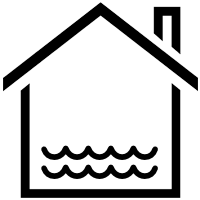
Basements add extra living or storage space but can be a risk for flooding, and ultimately a risk for water damage. A faulty sump pump or crack in a foundation are often causes for a basement taking on water. Water issues need to be resolved quickly to prevent extensive property damage and mold contamination.

A common cause of home or business water damage, a leaky pipe or a pipe burst can potentially cause a lot of damage. Particully if the leak or burst is behind a wall, ceiling or floor where that water can do damage without being immediately apparent.

Appliance malfunctions are the most common cause of water damage with washing machines #1 and water heaters coming in at #2. Loose or broken hoses or connectors in refrigerator water dispensers are also a culprit for causing water damage.

Bathtub and Toilet overflows and flooding are messy and a potential health hazard. Not only do we dry and remove the mess, we also clean, sanitize and deodorize the affected area. A sewage backup is considered a level 3 water loss.
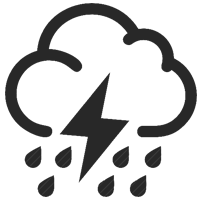
Flood, wind or lightning damage is a common occurrence for the midwest. When it happens you need a quick response to minimize loss. We have the resources and expertise to not only clean and repair, but also respond quickly.

Mold removal is serious business and can also be dangerous. Mold infestations typically creep up after water damage, like a basement or bathroom flooding or a leaky roof. Mold can also be present in HVAC systems!
Cincinnati Water Removal/Dry-Out Services
One of the most important steps after water damage is drying the area. After our water service technicians perform a thorough water extraction process, they will begin the drying process as soon as possible. This is important to prevent mold contamination and structural damage.
It is important to identify where the water is coming from when damage occurs. This allows us to eliminate the water and start drying out the affected area.
Do you have standing water?
When you have an event that leads to standing water, it’s important the situation is rectified in a timely manner. Otherwise, mold could begin to surface in the area. Mold can cause a musty smell and also be dangerous to your health. Mold spores can spread and can contaminate an entire area of your home.
Our water removal process consists of using powerful pumps to siphon the water out of the areas. We also have an extensive inventory of fans, blowers, dehumidifiers, sanitizers and disinfectants. These tools allow us to quickly get your home back to safe, normal or even better than before condition.
Content Restoration
Sometimes your items can be restored from damage like smoke, water, fire, or mold. However, time is crucial when it comes to water damage, and the homeowner must act quickly. This is just a portion of some of the items we can restore.
- Furniture
- Clothes
- Electronics
- Documents
- Keepsakes
- Medical Equipment
- And much more...
Why Choose Clarke Contractors Inc.?
Home or business, there are plenty of reasons why you should make Clarke Contractors your first choice for water damage restoration in Cincinnati...
- 20+ years in the industry gives us the experience that you need for an all-in-one, full service restoration company.
- Clarke Contractors has the equipment and resources to tackle jobs that other companies can’t handle.
- Our 24/7 fast response saves your property and gives you peace of mind. You might be able to save more of your personal items by choosing our services. When water and fire damage begin to take hold, they don’t wait for the repair company. You need a restoration company that has the know how to mitigate the damage and restore your property and contents.
- All of our work is backed by a one year, no-hassle satisfaction guarantee. The minute we make contact with you for a quote to the time we exit your home, your satisfaction is our priority.
- Our company has been the recipient of several major awards, including the BBB Torch Award, Best Water Damage Restoration Services in Cincinnati, Top 500 Remodeler, and many others.
- We work with all insurance companies and adjusters, making less stress for you.


Water Damage Restoration FAQs
How much does it cost to restore water damage?
According to Thumbtack, the national average in 2021 is around $2,400 - The homeowner's share of the cost will vary depending on a number of factors, including homeowner’s insurance coverage and others. Factors considered by a contractor to determine the final bill include nature and extent of the damage, type of materials affected, work that needs to be done for example ripping up carpets or replacing drywall as well as hours spent.
Does Insurance Cover Water Damage?
Most homeowners insurance policies will help cover water damage. There are exceptions. For example if your damage is caused by an ongoing Maintenance issue or if the damage is the result of a water backup from an outside sewer or drain. Separate flood insurance is required to make a claim for floods from water surges originating from rivers, ponds, lakes or oceans.
It's always best to confirm with your agent what is and what isn't covered before a water event happens. Asking questions like "Is my basement covered for water damage if my sump pump fails?" will help clarify if additional insurance is necessary or if covered through traditional homeowners.
What is Black Water, Water Damage?
One of the most dangerous losses that can occur at your home is a raw sewage back-up. Unlike small fires, wind damage or clean water floods, most of the damage can be cleaned or repaired on these types of losses. With raw sewage or what the standards call category 3 water loss, nothing can be saved.
Raw sewage is mainly gray or black water. It usually contains the organic waste and wastewater produced by household and industrial sources. Sewage typically contains everything from soap to solid waste, human excrement and debris. It is discharged by drains and sewer lines.
The IICRC S500 (Standard) defines category 3 loss as follows...
Category 3 water is referred to as “Black Water”. Black water contains pathogenic agents and is grossly unsanitary. Black water includes sewage and other contaminated water sources entering or affecting the indoor environment.
There are millions of different types of bacteria in sewage that include, but not limited to E coli, gastroenteritis and cryptosporidiosis. Most of those affected suffer stomach cramps and diarrhea, but untreated sewage can also spread horrible diseases such as cholera and hepatitis. Studies have indicated that one million people a year become ill as a direct result of sewer related problems.
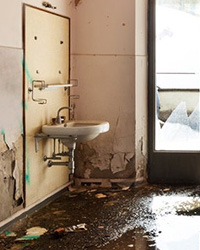
Pipe Burst? Here's what to do...
A pipe bursts or leaky hose can be tricky because they can happen in an unseen areas like behind a wall or in a cabinet or ceiling. When you do notice the damage you will need to act fast to prevent extensive damage to your property. A fast response to a burst pipe can save additional costs to restore your home or business back to its original condition.
Here are steps to take for a pipe burst:
- Turn off electricity, or call an electrician to turn off electric if needed
- Turn off the water source
- Salvage property contents if possible and move to dry area
- Call a damage restoration company to remove any standing water and dryout and sanitize effected area before mold or mildew grows
- Document all structural and content damage for insurance reference
- Repair and Restore any damaged structures
Basement Flood? Here's what to do...
Heavy rain, a pipe burst or faulty appliance can quickly turn your basement into wet mess.
It is important to act quickly to find the source of the water and if possible, stop the flooding. Try to clean and dry what you can to protect structures and content from water damage and potential mold growth.
Be Careful!
If you have a large amount of water, be sure to disconnect any electrical service to the area if you attempt to walk in the standing water.
Top 3 Must-Dos for a Flooded Basement
- Contact a Water Damage Specialist - Some water removal and restoration companies (like Clarke Contractors) will not only remove the water, clean, dry and sanitize the area but can likely also repair what caused the flood or leak. Find a restoration business with a good reputation and fast response time.
- Call Your Insurance - Review your responsibilities under your
policy for preventing additional damage.
- Document / Take Pictures - It's a good idea to take pictures and document the damage for insurance purposes.
- Wait for Help - When the restoration company arrives they will evaluate and determine equipment needed to begin the restoration process. The equipment may include water extractors, air movers and dehumidifiers. The process typically involves water removal, dry-out, cleaning and disinfecting, then repair and restoring to before damaged condition.

Mold After Water Damage - What to Look For
In the restoration business, one of the most common concerns encountered after water damage is the growth of mold. There are many different causes and warning signs that may help you identify without giving out the slightest of clues to their presence until they are well established. The more times they get to develop and grow, the bigger the problem becomes to both your personal heath and your property.
It is important to be able to identify and remove molds as soon as possible. Here are some warning signs you should know and be alert for.
Mold Triggers and Indicators:
- Humidity - Humidity is the prime factor for mold growth. It is recommended to keep humidity within the 30% to 50% range. Humidity above 60% creates the right conditions for molds to settle down and grow.
- Water Leaks - Leaks pertaining to roofs, pipes, rainwater pipes, plumbing systems, or small cracks on walls, windows or doors that let water penetrate in are dangerous. Mold needs moisture in order to grow and thrive. Many mold problems originate as a result of some kind of water intrusion, especially those that are not resolved quickly. If such leaks exist in your home, molds and mildews have probably already entered. Therefore as soon as you detect a leak, have it repaired.
- Damp Carpet - If your carpets, small or wall to wall, get wet somehow, you will need to take immediate action to get them dried. Spills, leaks, or pets can make your carpet wet. If you generally leave carpets to dry naturally, chances are good that mold has grown on the other side of the carpet. There are professional cleaning products that can clean carpets and prevent mold contamination.
- Stains - If you are noticing ugly spots around the kitchen sink, bathroom walls, bathtub and other areas in your house, chances are high that you have mold. Yellowish stains on walls and ceilings are a sign of excessive moisture. Molds are microscopic, but when mold forms colonies, they appear as ugly spots on the surface and may have a greenish, brownish or blackish discoloration to them. Prominent specks on the walls mean molds are in evidence and you may need to get a professional to inspect to find out other places in your house of contamination.
- Flooding - Mold infestation is very common after a flood. If the ground floor and basement of any building remains under water for a long period of time, it will take a long time for that area to dry out entirely, even when the water is drained or removed from the area. You need to be careful and start having the damaged area treated, even when there is no sign of mold infestation.
- Musty Odor - A musty odor is the most concrete proof of mold contamination. Molds produce VOC, Volatile Organic Compounds, which are responsible for the smell. When molds infect items, the objectionable smell alerts you about mold infestation. Musty odor is often the first indication of mold growth that you will actually observe. Mold removal and mitigation should help get rid of the offending odor.
While mold growth can cause damage to your property and health, it is a problem that can be recognized and corrected. Depending on the extent of the mold growth and locations of infiltration, fixing the problem can be as simple as a mild treatment to the areas or the removal and replacement of the affected areas. Clarke Contractors is a certified mold mitigation company.
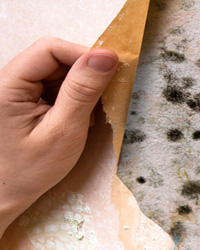
What is Ice Damming?
In colder months, ice damming is a common cause of cause water damage to walls, ceilings and insulation. Ice dams are formed when the heat from the inside of a home escapes into the attic and warms the roof decking in the winter. This heat, along with the heat from the sun, can melt the snow on the roof. This melting snow then runs down to the eaves, where there is no attic heat, and refreezes. The continual thaw and refreeze process creates ice dams at the edges of the roof and into the gutters. The result is water backing up under the roof shingles or behind the fascia boards where it soaks through the roof decking or wall sheathing causing water damage to attics, ceilings and walls.
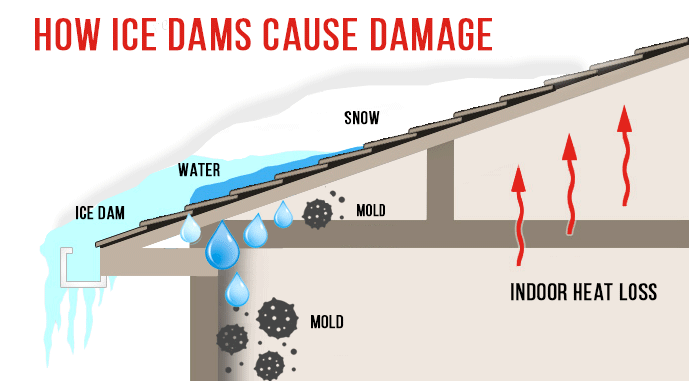
How to Prevent Ice Damming
There are three ways to defend against ice dams: insulation, ventilation and water proofing shingle underlayment. Each of the above will work together to keep ice damming and the damage it creates in check.
- Insulation keeps heat from escaping from your homes living space into your attic. Insulation levels are recommended by the geographic zone you may live in and are measured in R-values. R-value is the resistance to heat flow of a material. The higher the R-value, the greater the insulating power. If your home was built before 1980, chances are it needs more insulation or R-value to meet today’s standards.
- Ventilation removes the heat from your attic and helps keep the roof deck evenly cool to help prevent snow from melting on the roof. It is important to have ventilation in the attic so any heat lost from the interior of the home is drawn up and out of the attic. A properly designed ventilation system will have both intake vents in the soffits or eaves at the lower portion of the attic, as well as exhaust ventilation, such as ridge vents or turtle vents, at the high portions of the attic.
- Waterproofing shingle underlayment, or ice shield, is laid across the roof before roof shingles are installed. This ice shield will prevent leaks from dams that do form on the roof. With existing roofs, waterproofing shingle underlayment is only an option if you are removing the existing shingles and installing new ones.
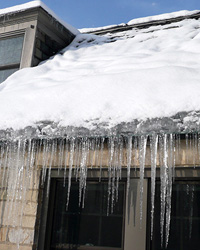
Related Blog Posts
Understanding the Science Behind Freezing Pipes When water freezes, it expands. This expansion can put pressure on the walls of…
Read more.
Sometimes it’s caused by a burst pipe or a faulty roof, or possibly a weather event… but know that for…
Read more.
Did you know these appliances that can cause water damage in your home? Most people think of flooding or burst…
Read more.
Water infiltration in basements is a common problem that many homeowners face in Ohio. Whether it’s due to heavy rainfall,…
Read more.
As the flowers begin to bloom, the arrival of spring is a time of renewal and growth. However, for many…
Read more.